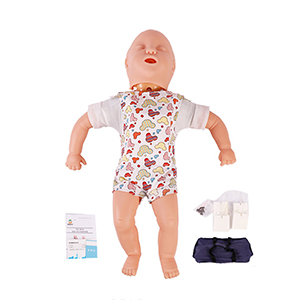Infant airway infarction and CPR model have irreplaceable advantages in first aid training, which are mainly reflected in the following aspects:
The infantile airway infarction and CPR model highly simulates the airway and chest structure of infants. This kind of simulation makes medical staff feel the difficulty and key points of first aid operation more truly when practicing, so as to help them better master first aid skills. At the same time, the model can simulate the physiological responses of infants during airway infarction and cardiac arrest, so that health care workers can perform targeted exercises in simulated emergency situations.

The model has multiple functions and can simulate various emergency situations such as infant airway infarction and cardiac arrest. Through the model, medical staff can practice first aid skills such as airway opening, foreign body removal, artificial respiration, chest compression, and learn how to properly use first aid equipment and drugs. This versatility allows the model to meet the needs of different levels of first aid training, from beginners to experts.
It is adjustable and the difficulty can be adjusted according to different training needs. For example, different degrees of airway obstruction and different degrees of cardiac arrest can be simulated to meet the training needs of different healthcare personnel. This adjustability makes the model more flexible and practical, and can adapt to a variety of complex first aid scenarios.
The model is made of high-quality materials with good durability and easy cleaning. Health care workers can practice using the model over and over again without worrying about damage or wear. At the same time, the safety of the model is also guaranteed, and it will not cause any harm to the medical staff or patients.
To sum up, infant airway infarction and CPR models have irreplaceable advantages such as high simulation, versatility, adaptability, safety and durability in first aid training. These advantages make the model an important tool to improve the first aid skills of medical personnel, helping them to make the right judgment and response in emergency situations.

